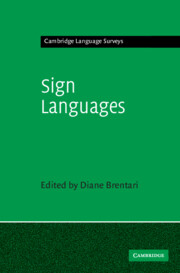1 - Introduction
Published online by Cambridge University Press: 05 June 2012
Summary
What are the unique characteristics of sign languages that make them so interesting? How is linguistic theory enriched by research on sign languages? Sign Languages: A Cambridge Language Survey tries to answer these questions. It is a collective work for which the whole is much greater than the sum of its parts. Differences among sign languages and Deaf communities will be described in its chapters as well as the common themes that point to convergence in the field. This volume addresses three areas of crosslinguistic study involving the family of sign languages: “transmission” of sign languages from one generation to the next, “shared crosslinguistic characteristics” and “variation and change.” The study of sign languages is still relatively young, and while the majority of scholarship on these languages has come from just a few of them, a great effort has been made to represent as full a range as possible in this book. More than forty sign languages are treated in this volume. Among the sign languages represented in this volume are older sign languages, including British, Italian and American Sign Language as well as younger sign languages such as Israeli, Al-Sayyid Bedouin and Nicaraguan Sign Languages. Sign languages from developing countries as well as economically more advanced countries are included. A wide range of geographic locations is also represented: Latin America, Asia, the Mid-East, Africa, as well as Northern, Southern and Eastern European countries.
- Type
- Chapter
- Information
- Sign Languages , pp. 1 - 16Publisher: Cambridge University PressPrint publication year: 2010
- 1
- Cited by



